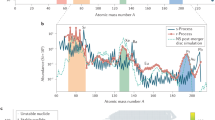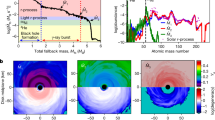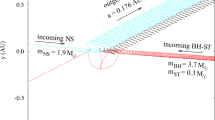Abstract
NEUTRON-STAR collisions occur inevitably when binary neutron stars spiral into each other as a result of damping of gravitational radiation. Such collisions will produce a characteristic burst of gravitational radiation, which may be the most promising source of a detectable signal for proposed gravity-wave detectors1. Such signals are sufficiently unique and robust for them to have been proposed as a means of determining the Hubble constant2. However, the rate of these neutron-star collisions is highly uncertain3. Here we note that such events should also synthesize neutron-rich heavy elements, thought to be formed by rapid neutron capture (the r-process)4. Furthermore, these collisions should produce neutrino bursts5 and resultant bursts of γ-rays; the latter should comprise a subclass of observable γ-ray bursts. We argue that observed r-process abundances and γ-ray-burst rates predict rates for these collisions that are both significant and consistent with other estimates.
This is a preview of subscription content, access via your institution
Access options
Subscribe to this journal
Receive 51 print issues and online access
$199.00 per year
only $3.90 per issue
Buy this article
- Purchase on Springer Link
- Instant access to full article PDF
Prices may be subject to local taxes which are calculated during checkout
Similar content being viewed by others
References
Clark, J. P. A. & Eardley, D. M. Astrophys. J. 215, 311–322 (1977).
Shutz, B. F. in Gravitational Collapse and Gravity (eds Sato, H. & Nakamura, T.) 246–253 (Singapore World Scientific, 1986).
Clark, J. P. A., van den Heuvel, E. P. J. & Sutantyo, W. Astr. Astrophys. 72, 120–128 (1979).
Lattimer, J. & Schramm, D. N. Astrophys. J. 210, 549–556 (1976).
Berezinsky, V. & Prilutski, P. Proc. 19th Int. Cosmic Ray Conf. 1, 29–32 (La Jolla, 1985).
Grindlay, J. E. & Bailyn, C. D. Nature 336, 48–50 (1988).
Ostriker, J. P. Sources of Gravitational Radiation (ed. Smarr, L. L.) 461–476 (Cambridge University Press, 1979).
Alpar, M. A., Cheng, A.F., Ruderman, M. A. & Shaham, J. Nature 300, 728–730 (1982).
Clark, J. P. A. Sources of Gravitational Radiation (ed. Smarr, L. L.) 447–459 (Cambridge University Press, 1979).
Arnett, W. D. & Bowers, R. L. Astrophys. J. Suppl. 33, 415–436 (1977).
Webbnik, R. F. Astrophys. J. 277, 355–360 (1984).
Mochkovitch, R. & Livio, M. Astr. Astrophys. 209, 111–118 (1989).
Benz, W., Bowers, R. L., Cameron, A. G. W. & Press, W. H. Astrophys. J. (in the press).
Itoh, N., Kohyama, Y. & Takenchi, H. Astrophys. J. 317, 733–736 (1987).
Webbink, R. F. & Iben, I. Jr in IAU Colloq. 95, The Second Conference on Faint Blue Star (eds Davis Philip, A. G., Hayes, D. S. & Liebert, J. W. 778 (L. Davis Press, Schenectady, 1987).
Page, D. N. Phys. Lett. A 91, 201–202 (1982).
Shapiro, S. in Numerical Astrophysics (eds Centrella, J., Leblanc, J. & Bowers, R.) 190, 215 (Bertlett, Boston, 1985).
Colpi, M., Shapiro, S. L. & Teukolsky, S. A. Astrophys. J. (in the press).
Lattimer, J. M., Mackie, F., Ravenhall, D. G. & Schramm, D. N. Astrophys. J. 213, 225–233 (1977).
Meyer, B. Astrophys. J. (in the press).
Symbalisty, E. M. D. & Schramm, D. N. Astrophys. Lett. 22, 132–145 (1982).
Burbidge, E. M., Burbidge, C. A., Fowler, W. A. & Hoyle, F. Rev. mod. Phys. 29, 547–650 (1957).
Norman, E. & Schramm, D. N. Astrophys. J. 228, 881–892 (1979).
Cameron, A. G. W., Cowan, J. & Truran, J. in Nucleosynthesis (eds Arnett, W. D. & Truran, J.) 190–201 (University of Chicago Press, 1985).
Berezinsky, V. & Prilutski, F. Proc. 20th Int. Cosmic Ray Conf. 1, 54–68 (Moscow, 1987).
Goodman, J. Astrophys. J. 308, L47–L50 (1986).
Babul, A., Paczynski, B. & Spergel, D. N. Astrophys. J. 316, L49–L54 (1987).
Shapiro, S. L. & Teukolsky, S. A. Black Holes, White Dwarfs and Neutron Stars (Wiley, New York, 1983).
Author information
Authors and Affiliations
Rights and permissions
About this article
Cite this article
Eichler, D., Livio, M., Piran, T. et al. Nucleosynthesis, neutrino bursts and γ-rays from coalescing neutron stars. Nature 340, 126–128 (1989). https://doi.org/10.1038/340126a0
Received:
Accepted:
Issue Date:
DOI: https://doi.org/10.1038/340126a0
Comments
By submitting a comment you agree to abide by our Terms and Community Guidelines. If you find something abusive or that does not comply with our terms or guidelines please flag it as inappropriate.



